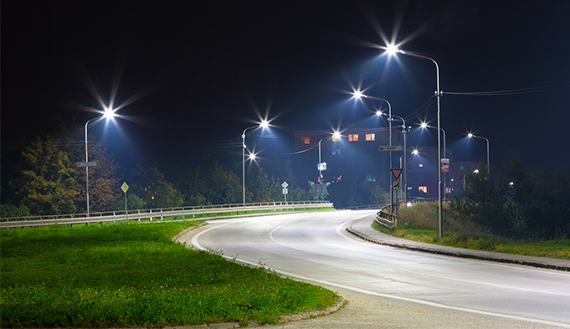
The Evolution of Street Lighting in the USA: A Journey of Illumination
Share
Street lighting in the United States has undergone a remarkable transformation throughout history. From humble oil candles to the cutting-edge LED technology of today, the progress has been extraordinary. Join us on a captivating journey through time as we explore the fascinating timeline of street lighting in the United States.
1757: Illuminating Beginnings - Benjamin Franklin, a visionary inventor, introduced street lighting to the United States. He improved upon the glass globes used in London and developed his own version, which was approved by the Pennsylvania Assembly. Franklin's design encased oil candles within a housing featuring four flat panes and a long funnel to draw up the smoke. This innovation reduced the need for frequent cleaning, as the previous glass globes tended to darken with soot.
1803: Gas Lights Emerge - Pelham Street in Newport, Rhode Island became the first road in America to embrace gas lights, pioneered by William Murdoch, who had invented them a decade earlier in 1792. This marked a significant step forward in street lighting technology.
1880: Electric Spark - Wabash, Indiana illuminated the way as the first town in the United States to introduce electric street lights. These lights, known as "Brush lights" after their inventor Thomas Brush, represented an early competitor to Thomas Edison's innovations. To this day, one of the original Brush lights can be admired at the Wabash County Courthouse.
1930s-1940s: Bright Incandescence and Fluorescent Brilliance - The early 20th century witnessed the popularity of incandescent and fluorescent lights for street lighting. However, their reign was short-lived as the introduction of mercury vapor lights quickly rendered them obsolete.
1950s: The Mercury Era - GE's Form 109 and Form 400, along with Westinghouse's OV-20, became the dominant street lights in America. These mercury lights set the standard during this era of illumination.
1957: Cobraheads Take Over - Westinghouse's OV-25 "Cobrahead" and GE's M400 "Cobrahead" improved upon their predecessors, solidifying their position as leading street lights in the United States.
1966: Embracing High Pressure Sodium - High Pressure Sodium (HPS) lights, known for their distinctive monochromatic yellow glow, were introduced. GE's second generation M250 and M400 HPS lights became the preferred choice due to their superior energy efficiency compared to mercury vapor lights, shaping the street lighting landscape for decades to come.
Metal Halide and Ceramic Metal Halide - Metal Halide lamps made their appearance in recent years, boasting a higher color rendering index (CRI) than the traditional yellow sodium lamps. However, their energy efficiency has not surpassed that of HPS lights. Ceramic Metal Halide lamps, an improvement on traditional metal halide, show potential as replacements for HPS lamps unless LED lights can outperform them.
2006-Present: The LED Revolution - Ann Arbor, Michigan blazed the trail by implementing LED street lighting, and the trend quickly spread across the nation. Anchorage, Alaska installed 4,000 LED streetlights in 2008, followed by Los Angeles replacing 140,000 streetlights with LEDs over a five-year period starting in 2009. Seattle also embarked on a five-year plan in 2010 to implement 40,000 LED lights. Major cities such as Philadelphia, New York, and San Antonio are actively researching and implementing their own LED retrofit initiatives.
The Future Shines Bright - While LED technology initially carried higher up-front costs compared to traditional lighting solutions, the economic landscape has rapidly changed. The upfront costs of LED retrofit projects have significantly decreased, making them economically feasible. The return on investment over time
1757: Illuminating Beginnings - Benjamin Franklin, a visionary inventor, introduced street lighting to the United States. He improved upon the glass globes used in London and developed his own version, which was approved by the Pennsylvania Assembly. Franklin's design encased oil candles within a housing featuring four flat panes and a long funnel to draw up the smoke. This innovation reduced the need for frequent cleaning, as the previous glass globes tended to darken with soot.
1803: Gas Lights Emerge - Pelham Street in Newport, Rhode Island became the first road in America to embrace gas lights, pioneered by William Murdoch, who had invented them a decade earlier in 1792. This marked a significant step forward in street lighting technology.
1880: Electric Spark - Wabash, Indiana illuminated the way as the first town in the United States to introduce electric street lights. These lights, known as "Brush lights" after their inventor Thomas Brush, represented an early competitor to Thomas Edison's innovations. To this day, one of the original Brush lights can be admired at the Wabash County Courthouse.
1930s-1940s: Bright Incandescence and Fluorescent Brilliance - The early 20th century witnessed the popularity of incandescent and fluorescent lights for street lighting. However, their reign was short-lived as the introduction of mercury vapor lights quickly rendered them obsolete.
1950s: The Mercury Era - GE's Form 109 and Form 400, along with Westinghouse's OV-20, became the dominant street lights in America. These mercury lights set the standard during this era of illumination.
1957: Cobraheads Take Over - Westinghouse's OV-25 "Cobrahead" and GE's M400 "Cobrahead" improved upon their predecessors, solidifying their position as leading street lights in the United States.
1966: Embracing High Pressure Sodium - High Pressure Sodium (HPS) lights, known for their distinctive monochromatic yellow glow, were introduced. GE's second generation M250 and M400 HPS lights became the preferred choice due to their superior energy efficiency compared to mercury vapor lights, shaping the street lighting landscape for decades to come.
Metal Halide and Ceramic Metal Halide - Metal Halide lamps made their appearance in recent years, boasting a higher color rendering index (CRI) than the traditional yellow sodium lamps. However, their energy efficiency has not surpassed that of HPS lights. Ceramic Metal Halide lamps, an improvement on traditional metal halide, show potential as replacements for HPS lamps unless LED lights can outperform them.
2006-Present: The LED Revolution - Ann Arbor, Michigan blazed the trail by implementing LED street lighting, and the trend quickly spread across the nation. Anchorage, Alaska installed 4,000 LED streetlights in 2008, followed by Los Angeles replacing 140,000 streetlights with LEDs over a five-year period starting in 2009. Seattle also embarked on a five-year plan in 2010 to implement 40,000 LED lights. Major cities such as Philadelphia, New York, and San Antonio are actively researching and implementing their own LED retrofit initiatives.
The Future Shines Bright - While LED technology initially carried higher up-front costs compared to traditional lighting solutions, the economic landscape has rapidly changed. The upfront costs of LED retrofit projects have significantly decreased, making them economically feasible. The return on investment over time
